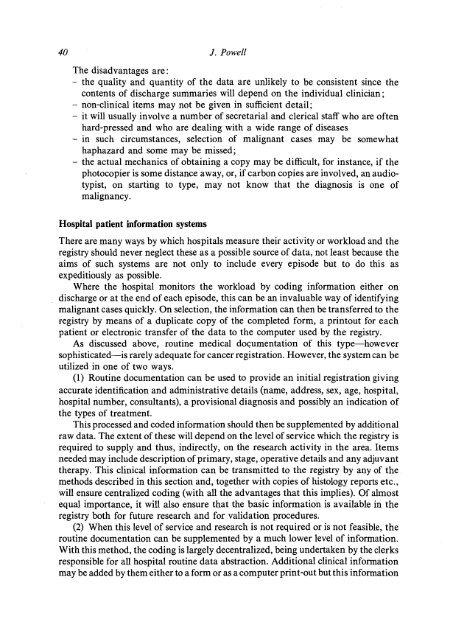Cancer Registration: Principles and Methods - IARC
Cancer Registration: Principles and Methods - IARC
Cancer Registration: Principles and Methods - IARC
You also want an ePaper? Increase the reach of your titles
YUMPU automatically turns print PDFs into web optimized ePapers that Google loves.
The disadvantages are :<br />
- the quality <strong>and</strong> quantity of the data are unlikely to be consistent since the<br />
contents of discharge summaries will depend on the individual clinician;<br />
- non-clinical items may not be given in sufficient detail;<br />
- it will usually involve a number of secretarial <strong>and</strong> clerical staff who are often<br />
hard-pressed <strong>and</strong> who are dealing with a wide range of diseases<br />
- in such circumstances, selection of malignant cases may be somewhat<br />
haphazard <strong>and</strong> some may be missed;<br />
- the actual mechanics of obtaining a copy may be difficult, for instance, if the<br />
photocopier is some distance away, or, if carbon copies are involved, an audiotypist,<br />
on starting to type, may not know that the diagnosis is one of<br />
malignancy.<br />
Hospital patient information systems<br />
There are many ways by which hospitals measure their activity or workload <strong>and</strong> the<br />
registry should never neglect these as a possible source of data, not least because the<br />
aims of such systems are not only to include every episode but to do this as<br />
expeditiously as possible.<br />
Where the hospital monitors the workload by coding information either on<br />
discharge or at the end of each episode, this can be an invaluable way of identifying<br />
malignant cases quickly. On selection, the information can then be transferred to the<br />
registry by means of a duplicate copy of the completed form, a printout for each<br />
patient or electronic transfer of the data to the computer used by the registry.<br />
As discussed above, routine medical documentation of this type-however<br />
sophisticated-is rarely adequate for cancer registration. However, the system can be<br />
utilized in one of two ways.<br />
(1) Routine documentation can be used to provide an initial registration giving<br />
accurate identification <strong>and</strong> administrative details (name, address, sex, age, hospital,<br />
hospital number, consultants), a provisional diagnosis <strong>and</strong> possibly an indication of<br />
the types of treatment.<br />
This processed <strong>and</strong> coded information should then be supplemented by additional<br />
raw data. The extent of these will depend on the level of service which the registry is<br />
required to supply <strong>and</strong> thus, indirectly, on the research activity in the area. Items<br />
needed may include description of primary, stage, operative details <strong>and</strong> any adjuvant<br />
therapy. This clinical information can be transmitted to the registry by any of the<br />
methods described in this section <strong>and</strong>, together with copies of histology reports etc.,<br />
will ensure centralized coding (with all the advantages that this implies). Of almost<br />
equal importance, it will also ensure that the basic information is available in the<br />
registry both for future research <strong>and</strong> for validation procedures.<br />
(2) When this level of service <strong>and</strong> research is not required or is not feasible, the<br />
routine documentation can be supplemented by a much lower level of information.<br />
With this method, the coding is largely decentralized, being undertaken by the clerks<br />
responsible for all hospital routine data abstraction. Additional clinical information<br />
may be added by them either to a form or as a computer print-out but this information
















